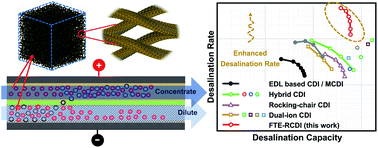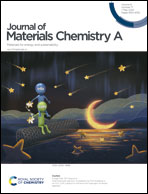Rocking-chair capacitive deionization with flow-through electrodes†
Abstract
Capacitive deionization (CDI) has emerged as a promising alternative for saline water desalination, yet the relatively slow desalination rate curtails its practical application. Motivated by the goal of simultaneously enhancing the desalination capacity and rate, this paper reports a new type of flow-through rocking-chair capacitive deionization (FTE-RCDI) system for the first time utilizing a sodium-pre-intercalated MnO2 coated carbon nanofiber aerogel (CNFAs@NaxMnO2) as the flow-through electrode. The performance of the FTE-RCDI system in terms of desalination capacity, desalination rate, and energy consumption is systematically studied. Owing to the integration of the unique dual-mode of sodium storage, high redox-active surface area, and good electrical conductivity of the CNFAs@NaxMnO2 and the superior flow-through cell architecture into one, the as-designed FTE-RCDI system exhibits excellent desalination performance with a desalination capacity of 59.35 mg g−1, desalination rate up to 0.46 mg g−1 s−1 (almost the highest value among those of all the reported CDI related systems), and a specific energy consumption as low as 0.55 J mg−1. This work is interesting because it not only exemplifies the significance in both the rational design of electrode materials and the cell architecture for boosting CDI performance, but also provides inspirations for the future design of highly efficient CDI systems.



 Please wait while we load your content...
Please wait while we load your content...